Thermosetting plastics compression molding process
Plastic compression molding is a method of compression molding. It is the oldest plastic molding technology and one of the more important molding methods for thermosetting plastics
Welcome to the forefront of precision manufacturing with our state-of-the-art plastic compression molding factory. We specialize in creating high-quality compression moulding plastic products MOLD that set the standard for durability and performance. Utilizing the latest in plastic compression moulding process technology, we deliver components with exceptional strength and finish. Our expertise lies in crafting a wide range of plastic compression moulding products, from electrical insulators to automotive parts, each designed to meet the specific needs of your industry. Trust our experienced team to bring your compression plastic moulding mold vision to life with efficiency and excellence.
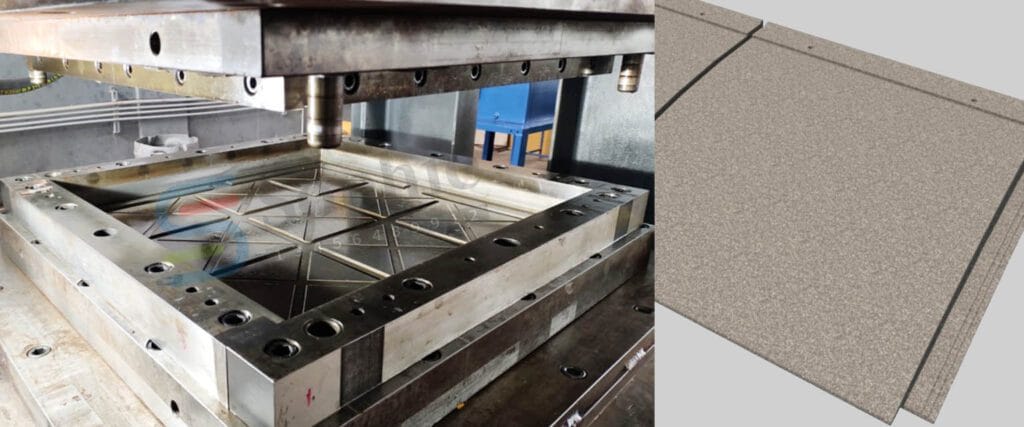

What is thermosetting plastics compression molding process
Thermosetting plastic compression molding is a process that uses molds to pressurize and solidify thermosetting plastic raw materials under high temperature and high pressure conditions to obtain plastic products of the desired shape. This technology has the advantages of stable product size, high surface quality, and high production efficiency. It is widely used in electrical, automotive, aerospace and other fields.
The compression plastic moulding process mainly utilizes the characteristics of each stage in the resin curing reaction to realize product molding, including the plasticization of the molding material, the flow and filling of the mold cavity, and the curing of the resin. Since the resin and the reinforcing material must flow along with the flow of the molding material filling the mold cavity, the molding pressure of the compression molding process is relatively high, which belongs to high-pressure molding. This requires the use of a hydraulic press that can control the pressure, as well as a high-strength, high-precision, high-temperature resistant metal mold.
Compression molding is the oldest and most important process in polymer material molding and processing technology. Almost all polymer materials can be molded into products using this method. Considering production efficiency, product size, and product usage characteristics, it is currently mainly used for: thermosetting plastics, rubber products, and composite materials. This article mainly introduces the process performance, molding equipment, molding process, molding process conditions and control of thermosetting plastic compression molding.
Characteristics of compression molding of thermosetting plastics
The plastic is placed in the cavity of the metal mold, and then the mold is closed and heated and pressurized to make the plastic melt and flow, filling the cavity. After proper air release and pressure maintenance, the plastic is fully cross-linked and solidified into a product.
- The molding process and equipment are mature, and it is an older molding process. The equipment and mold are simpler than injection molding.
- Intermittent molding has a long production cycle, low production efficiency, high labor intensity, and is difficult to automate.
- The product quality is good, and no internal stress or molecular orientation will be generated.
- It can press products with a larger area, but cannot press products with complex shapes and large thickness.
- After the product is formed, it can be demolded while hot.
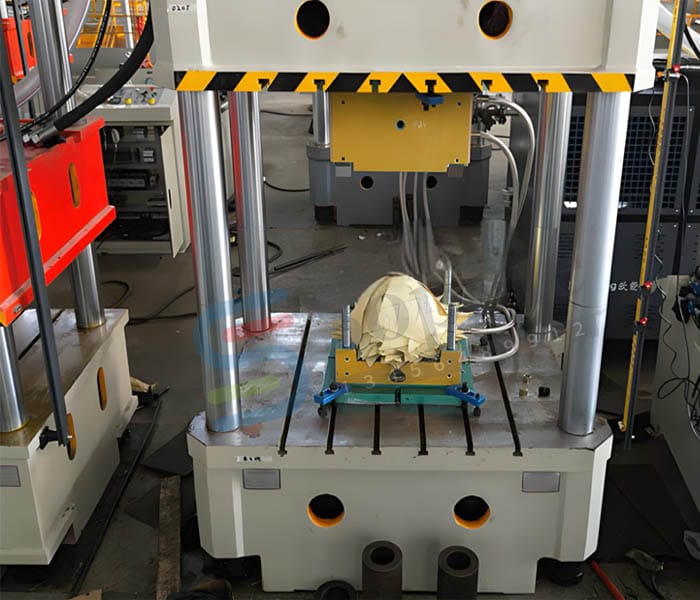
During the molding process, thermosetting plastics are transformed into a plastic viscous state under heating and pressure, and the fluidity increases to fill the cavity. At the same time, condensation reaction occurs, the cross-linking density continues to increase, the fluidity decreases rapidly, and the molten material gradually solidifies. When designing the mold, it is necessary to consider materials with fast hardening speed and short fluidity to facilitate loading, loading and unloading of inserts, and to select reasonable molding conditions and operations to avoid premature hardening or insufficient hardening, resulting in poor molding of plastic parts.
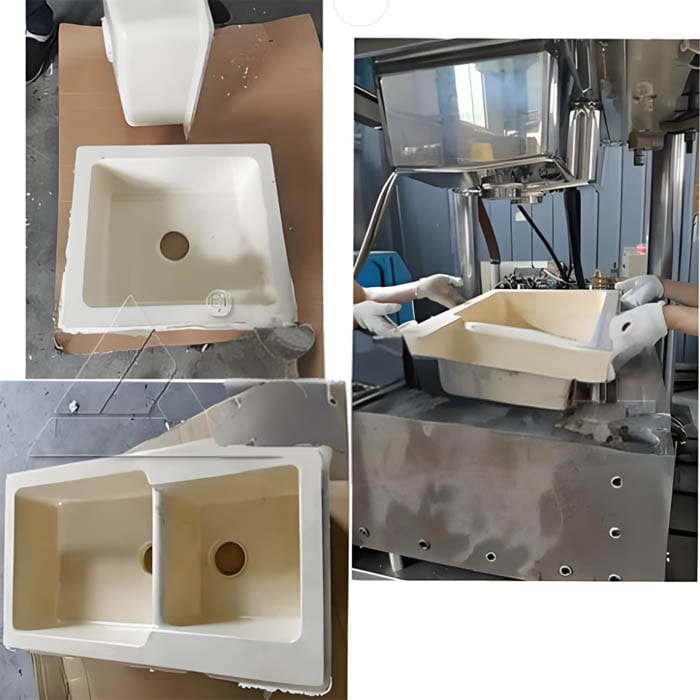
Performance of compression molding of thermosetting plastics
1. Fluidity
Fluidity, or plasticity, is extremely important for molding processing and directly affects the physical and chemical behavior of thermosetting plastics during molding and the quality of the product.
Factors affecting fluidity
Performance and composition of compression molded plastics (molecular weight, particle shape, small molecules); mold and molding conditions (smoothness, flow channel shape, preheating)
Consequences of excessive or insufficient fluidity
- Too large: overflow from the mold, the plastic is not tightly packed in the cavity, or the resin and filler gather separately.
- Too small: difficult to fill the cavity under pressure, resulting in material shortage, and inability to mold large, complex and thick products.
2. Curing rate
It is used to measure the speed of chemical reaction (cross-linking) of thermosetting plastics during compression molding.
The curing speed depends on: the cross-linking reaction properties of the plastic, the specific conditions during molding: pre-pressing, preheating, molding temperature and pressure.
Too fast curing speed: hardening too fast, premature hardening, reduced fluidity, failure to fill the cavity well, product shortage, failure to press thin-walled and complex-shaped products. Appearance: the surface solidifies first, poor fluidity.
Too slow curing speed: production cycle ↑, production efficiency ↓.
3. Molding shrinkage
4. Compression ratio
The thermal expansion coefficient of polymer materials is much larger than that of molds (steel). Cross-linking occurs during the molding of thermosetting plastics, and the structure tends to be compact. In addition, low molecular weight substances volatilize, and the volume must shrink, and the size changes greatly.
Molding shrinkage: SL=(L0-L)/L× 100%
The SL of general polymer materials is 1-3%, which is an important indicator for mold design.
The basic reasons for shrinkage: changes in chemical structure (cross-linking), thermal shrinkage, elastic recovery, and plastic deformation.
Factors affecting shrinkage: process conditions, mold and product design, and plastic properties.
Consequences: product warping and cracking.
Solution: preheating, use of non-overflow molds, and strict process regulations.
It is the ratio of the apparent specific gravity of powdered or granular thermosetting plastics to the specific gravity of the finished product. That is, the volume change of molded plastics before and after compression.
- Compression ratio: Rp=d2/d1=V1/V2
- Consequences: The larger the Rp, the larger the mold loading chamber required – it consumes mold steel, is not conducive to heat transfer, has low production efficiency, and is easy to mix with air;
- Solution: Pre-compression: Phenolic compressed powder is pre-compressed: Rp changes from 2.8 to 1.25.
5. Water and volatile content
Free water, as well as ammonia, formaldehyde and bound water released when heated and compressed, are too high, resulting in the following consequences:
Excessive fluidity, large shrinkage, warping, dullness and ripples.
Solution: Preheat and fully dry the material to reduce the water content in the material.
6. Fineness and uniformity
Fineness: particle diameter size;
Uniformity: the difference in diameter between particles.
Plastic compression molding is a method of compression molding. It is the oldest in plastic molding technology and one of the more important molding methods for thermosetting plastics. Compression molding can be divided into compression molding and lamination molding according to the properties of the material and the characteristics of the molding process. Compression molding is also called compression molding. This molding method is to put powdered, granular, crumb or fibrous plastic into a heated mold and heat it to melt it. Under the action of pressure, the material fills the mold cavity to form a molded product with the same shape as the mold cavity.
Compression molding equipment and molds
Molding equipment - Hydraulic Press
The function of the press: to transfer heat and apply pressure to the plastic through the mold; to provide the necessary conditions for molding: to open the mold and eject the product.
Press – mechanical pressurization, hydraulic (upper press, lower press)
The upper press type: The pressing cylinder is located at the top of the hydraulic press, and the movable crossbeam is pushed by the cylinder piston (or plunger) to apply pressure from top to bottom. The lower crossbeam is fixed as a workbench. This press is easy to operate.
Downward pressure type: The pressing cylinder is located at the bottom of the hydraulic press, the upper beam is fixed, and the lower beam is pushed by the cylinder piston (or plunger) to pressurize from bottom to top. This type of press has two upper and lower beams, the center of gravity of the whole machine is low, and the stability is good.
Molding Tooling-Mould
There are many types of molds (steel), and the structure is usually simple. There are three common molds used for compression molding:
1) overflow mold
2) non-overflow mold
3) semi-overflow mold


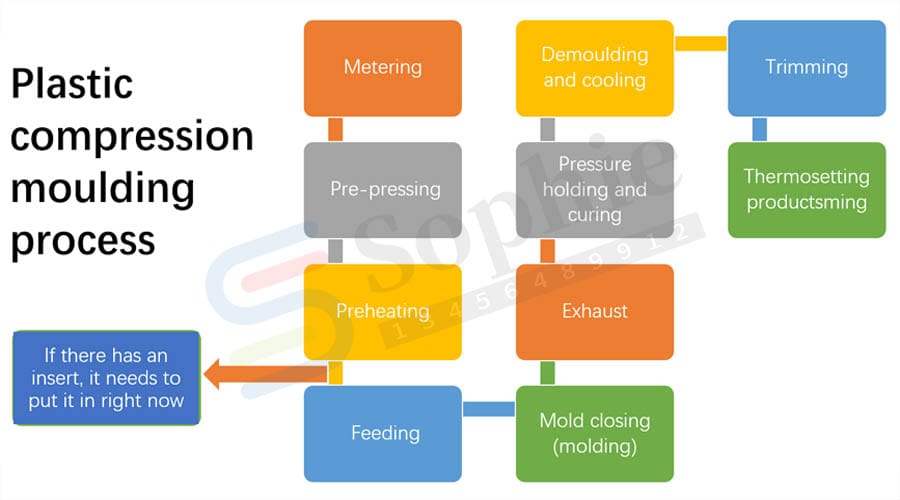
Plastic compression moulding process
Most of the compression molding plastics are made of thermosetting resins with powdered or fibrous fillers and other additives.
The process flow of compression molding is shown in the figure on the left:
1. Metering
Weight method: Add material by mass. Accurate but troublesome.
Volumetric method: Add material by volume. Convenient but not as accurate as weight method.
Counting method: Count by pre-pressed blanks. The operation is the fastest, but there is a pre-pressing metering operation in advance.
2. Pre-pressing
Advantages of pre-pressing: fast, accurate, simple and easy to operate. Reduce the compression rate and reduce the amount of material in the mold. Reduce the air content in the material, which is conducive to heat transfer. Improve the preheating procedure. (The preheating temperature can be increased after pre-pressing)
Disadvantages: Add one more process and high cost.
Pre-pressing pressure: Generally, it is appropriate to control the density of the pre-pressed material to 80% of the maximum density of the product.
Pre-pressing pressure range: 40~200MPa
3. Preheating
Heating thermosetting plastics before molding has the dual meaning of preheating and drying.
Advantages of preheating: Accelerate the curing speed and shorten the molding time. Improve fluidity and enhance the uniformity of curing. Reduce the internal stress of the product and improve the quality of the product. Reduce the molding pressure. Preheating: 15~20MPa, non-preheating: 25~35MPa
The preheating time is related to the preheating temperature. Once the preheating temperature is determined, a curve of the relationship between the preheating time and the molding fluidity can be drawn through experiments, and then the preheating time corresponding to the best fluidity can be found on the curve.
- Preheating method:
Hot plate heating, oven heating
Far infrared heating, high frequency heating
The preheating time is related to the preheating temperature. Once the preheating temperature is determined, a curve of the relationship between the preheating time and the molding fluidity can be drawn through experiments, and then the preheating time corresponding to the best fluidity can be found on the curve.

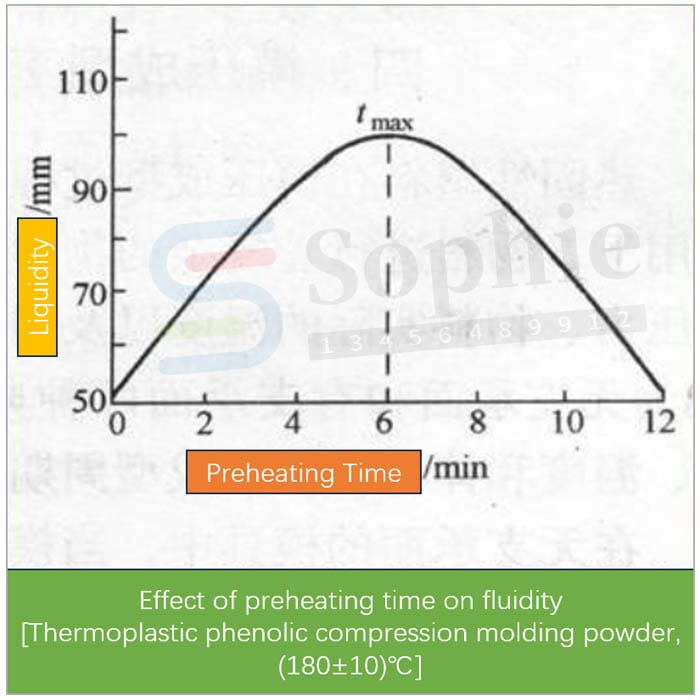
The preheating time is related to the preheating temperature. Once the preheating temperature is determined, a curve of the relationship between the preheating time and the molding fluidity can be drawn through experiments, and then the preheating time corresponding to the best fluidity can be found on the curve.
4. Insert placement
5. Feeding (Adding materials)
Inserts are usually the conductive part of a product, or used to connect the product with other objects. The placement requirements are: correct and stable.
6. Mold closing (molding)
After the material is added, the male and female molds are closed. It should be fast first and then slow – before the male mold contacts the material, the mold closing speed should be as fast as possible, and when the male mold is about to contact the material, the mold closing speed should be slowed down.
Advantages of fast first: It is conducive to shortening non-production time; avoiding plastic solidification before pressure is applied; avoiding plastic degradation.
Advantages of slow later: Preventing mold damage and insert displacement; It is conducive to fully removing air in the mold.
8. Pressure holding and curing
Under certain P and T, after a certain t, the polycondensation reaction reaches the required crosslinking degree. Theoretically, after curing, the originally soluble and fusible linear resin becomes an insoluble and infusible bulk structure material.
In actual operation, the entire curing process is not necessarily completed in the curing stage, but in the “post-baking” process after demoulding. To improve equipment utilization. Example: Post-baking temperature of phenolic plastic: 90-150℃, time: several hours to dozens of hours
If the amount of material added is too much, the product will have thick burrs and be difficult to demold; if the amount of material added is too little, the product will be loose and have poor gloss; so the amount of material added must be accurate. The feeding process emphasizes accurate feeding and reasonable stacking. Generally, it should be stacked in the form of “high in the middle and low around”. Reason: It is conducive to exhaust; less material is punched when the mold contacts the material during mold closing.
7. Exhaust
Reason for exhaust: Thermosetting plastics will release small molecules due to chemical reactions such as polycondensation during processing, and expand in volume at the molding temperature to form bubbles.
Function of exhaust: drive away bubbles, moisture, volatiles, shorten the curing cycle, and avoid bubbles or stratification inside the product.
Ways of exhaust: Unload pressure, loosen the mold, the time is very short (a few tenths of a second to a few seconds), and do this several times in a row (2 to 5 times).
The number of exhausts and interval time are determined by the properties of the molded material.
9.Demoulding and cooling
Thermosetting plastics can be demolded while hot, usually by ejector pins. Two issues must be noted in hot demolding: preventing cooling warping and preventing internal stress.
10 .Trimming (Post-processing)
Heat treatment – eliminate internal stress; further solidify until fully solidified. The treatment temperature is 10 to 50 ° C higher than the molding temperature. Finishing – trimming to get thermosetting products
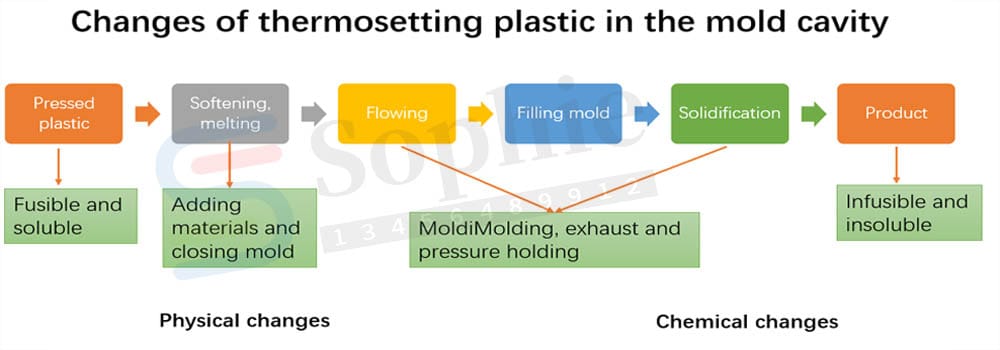
Compression Molding Process Conditions and Control
During the whole process, thermosetting resins not only undergo physical changes, but also complex chemical cross-linking reactions. The result of heating and pressurizing outside the mold: While chemical and physical changes are taking place inside the mold cavity, the pressure inside the mold, the volume of the plastic, and the temperature also change accordingly.
3 major process factors: molding pressure, molding temperature and molding time
Molding pressure
Function: Promote material flow, fill the cavity to improve molding efficiency, increase product density, improve the intrinsic quality of the product, overcome the pressure generated by the released low molecular weight substances and volatile substances in the plastic, thereby avoiding bubbles, swelling or delamination of the product, close the mold, and give the product shape and size
Molding temperature
That is, the mold temperature during molding. The melting of plastics comes from the heat transfer of the mold. The molding temperature is mainly determined by the nature of the plastic – the requirements of cross-linking.
Mold temperature affects: the fluidity of the plastic, whether the filling is smooth during molding, the hardening speed, and the quality of the product.
The consequences of too high mold temperature:
- Decomposition of resin and organic matter
- The hardening speed is too fast, causing the outer layer to solidify first and no longer flow, making it difficult for gas to be discharged, product shortage, internal stress ↑, product quality ↓
The consequences of too low mold temperature:
- Insufficient hardening, quality degradation
- Long hardening cycle
Compression molding temperature of daily molding materials (PF, UF): 145~155℃
Molding time
The time from the time the plastic is filled with mold and pressurized to the time it is completely solidified.
The length of the molding time is determined by:
- The hardening speed (related to the type of resin)
- The shape and thickness of the product
- The molding process conditions: T, P
- Whether the net is pre-pressed and preheated
Generally: T↑, fast curing, molding time↓, cycle↓
P has no obvious effect, but P↑, molding time slightly↓
In short, a long molding time can make the product cross-linked and cured completely, and the performance will increase. But if the molding time is too long, the production efficiency will decrease; long-term high temperature will degrade the resin. If the molding time is too short, the hardening is insufficient, the appearance is dull, and the performance will decrease. Generally, the molding time of PF and UF is: 1min/1mm product thickness.
The process conditions of molding: pressure, temperature, and time should be considered comprehensively. General principle: Under the premise of ensuring the quality of the product, reduce the pressure, temperature and shorten the time as much as possible.
For thermoplastics plastic, the production cycle is long, the productivity is low, and the mold is easily damaged due to the alternating heating and cooling of the mold. Therefore, this method is rarely used in production. However, this method can be used for thermosetting plastics with a large molding area. The plastics processed by the molding method mainly include phenolic plastics, amino plastics, epoxy resins, silicones, rigid polyvinyl chloride, polyethylene, and copolymers of ethylene vinyl acetate, etc.
The future development trend of thermosetting plastic compression molding technology includes high efficiency, intelligence and environmental protection. By optimizing the process flow and improving the mold precision, the compression molding efficiency can be further improved and the production cost can be reduced. At the same time, with the help of advanced automation equipment and control systems, the intelligent management of the compression molding process can be realized to improve production efficiency and product quality. In addition, the use of environmentally friendly thermosetting plastic raw materials and green production processes can reduce environmental pollution in the production process and achieve sustainable development.